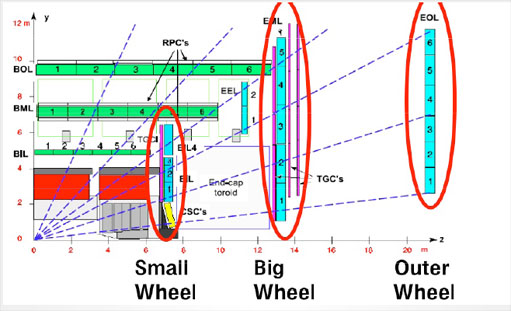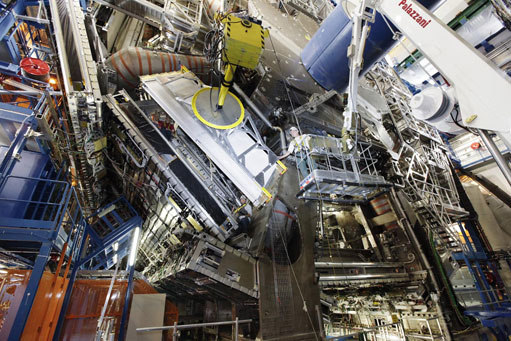
ATLAS e-News
23 February 2011
First Muon EE chambers installed
7 September 2009

Attaching an EE chamber to the installation tool
Several new parts of the ATLAS Muon Spectrometer have been installed earlier than anticipated. The so-called ‘EE’ chambers – where EE denotes their positioning as part of an ‘extra endcap’ – were due to join the detector during the 2009-10 winter shutdown. But, making the most of a clear window following the combined run this summer, the muon team and Technical Coordination decided to introduce 10 of the 62 Monitored Drift Tube (MDT) chambers ahead of schedule.
The chambers, which sit between the Big and Small Wheels, and around the Endcap Toroid magnet at each end of the detector, will provide an extra layer of muon measurement in the ‘rapidity region’ 1 to 1.3. Particles that shoot either straight out of the barrel, perpendicular to beam direction, or those nearly parallel to beam direction, will pass through three layers of muon system. But the 1-1.3 region, where the horizontally laid chambers give way to vertical ones, is something of a no-man’s-land only covered by two layers.
“We ideally want three or more measured points in order to completely reconstruct particle momentum and other parameters,” explains co-deputy Muon Project Leader, Tatsuo Kawamoto. The installation of the 10 EE chambers in July means that, theoretically, the accuracy of momentum measurements in that region of the detector should be much improved.

Dotted lines demonstrate how the EE chambers provide an extra layer of detection for some particle trajectories.
Like much of the rest of the muon system, the EE chambers are made of two ‘multilayers’ of three layers of drift tubes. The chambers, produced in Russia, measure very approximately 5 metres by 2 metres by 40 centimetres, and weigh in at 170 kilograms each. The 16 sectors around the Endcap Toroid are each covered by two trapezium shaped chambers, with the exception of Sector 5, which has just one.
The initial plans earmarked the 2009-10 shutdown as the time when all 62 chambers would make their debut. Since that shut down will no longer take place and there was time available for the installation earlier this year, the teams involved decided to begin it ahead of time. The result of this is that 10 chambers are now in place for first data – an unexpected bonus.
In fact, Sector 5 on both sides of the detector had been installed since February this year. Unlike the other chambers, it sits permanently atop the Endcap Toroid, which it uses as a support structure. In a neat bit of design trickery, when the Endcap Toroid is moved outwards it reveals the now partially-installed support structures for the small chambers (which reside in the even Sectors 2 -16): a double aluminium rail, consisting of two concentric circles.
When the detector is semi-open, and the support rails are exposed at Sector 5, the other chambers can be cleverly slotted into the absent Sector 5 position and shimmied along into their rightful places, tucked just inside the Barrel Toroid magnets. “In this way the chambers will arrive in their final position behind the magnet coils. This position is very difficult to reach from the front of the detector,” explains Muon Project Leader Ludovico Pontecorvo.
The July operation, which focussed on the large sectors instead, took some careful planning though. “For the installation, it was necessary to dismount the cryogenic pumps of the toroid. This is a rather nasty operation for the magnet team, because the pumps weigh around 300 kilos,” explains Ludovico.

Placing an EE chamber
During the two-week operation, the engineers installed Sectors 11 and 13 on Side A and Sectors 13 and 15 on Side C – a total of eight large chambers. They even managed not to have to dismantle the pumps in Sector 13, in what Tatsuo describes as “a very acrobatic operation”.
He and Ludovico anticipate installing the remainder of the chambers and the small chamber support structures whenever the next long shutdown comes around. “We can’t install the rest of the superstructures this year because we need to dismantle some gangways for that, and it’s a large job,” Tatsuo explains. When all the chambers are in place, we can expect a factor of two or three improvement in muon momentum resolution in the region.
“We’d really like to thank the technicians who have done these tricky operations and the engineers who designed the rather complicated mechanical structure,” smiles Ludovico. “There was a huge effort of the technical coordination and in particular the technicians doing this very delicate operation.”

Ceri PerkinsATLAS e-News
|